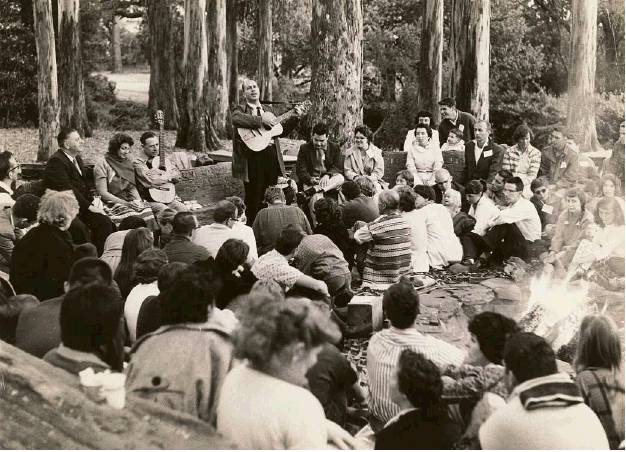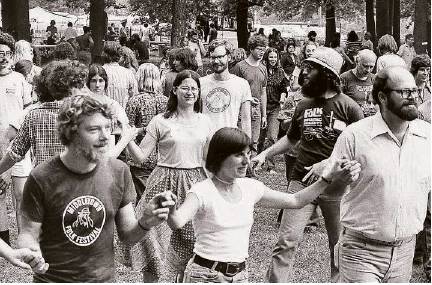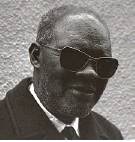Tape trove captures Bay Area folk revival
Recordings made by local enthusiast in ’50s, ’60s become album on Folkways
By Joshua Kosman
If you happened to frequent folk music events in Northern California in the late 1950s or ’60s, it’s likely you would have run across a burly aficionado armed with a heavy reel-to-reel tape recorder. Whatever the occasion — the annual iterations of the Berkeley Folk Music Festival, performances in clubs like the still-thriving Freight & Salvage, or casual house parties where musicians gathered to play and sing — Alan Oakes was apt to be there, documenting the proceedings.
Now Oakes’ legacy, drawn from a trove of some 40 hours’ worth of onsite recordings, has been made available for a wider audience. “The Village Out West: The Lost Tapes of Alan Oakes,” a meticulously prepared album set for release Friday, Sept. 24, by Smithsonian Folkways, uses Oakes’ field recordings to provide a panoramic view of the folk music revival as it unfolded over more than a decade in Berkeley, Marin and Fresno.
The 51 selections include an array of musicians that range from headliners of the national scene — including blues master Mississippi Fred Mc-Dowell, the gospel singer the Rev. Gary Davis and the legendary guitar picker Doc Watson — to performers of local stature. As the title suggests, this was a world at once parallel to and distinct from the better-known folk revival that was taking place at the same time in New York’s Greenwich Village.
“The difference is that New York started out with much more textured infrastructure,” explained Henry Sapoznik, the performer and historian of traditional music who served as a co-producer for the project. “There were more record labels, more small-power radio stations, more clubs.
“THE VILLAGE OUT WEST: THE LOST TAPES OF ALAN OAKES” is available for purchase for $25 starting Friday, Sept. 24.
“The Bay Area didn’t have those things, so it had to invent itself.”
The stylistic variety and scope of these recordings are themselves remarkable. Watson is joined by two Bay Area musicians, fiddler Hank Bradley and banjoist Rick Shubb, for a vivacious account of the fiddle tune “Beaumont Rag.” Singer Allan Mac-Leod offers an unaccompanied version of “The Hounds Are Out,” an English hunting ballad from the 19th century.
The vocal duo Kathy and Carol, best known for singing traditional American and English ballads, swing into “Searchin’,” the Leiber and Stoller song made famous by the Coasters. There are “talking blues” and Cajun dance melodies and comic novelty songs, too.
“The attitude was, ‘We’ll play this particular tune, and you play it your way and I’ll bring my influences,’ ” said producer Deborah Robins, who spearheaded the project. “That’s why this doesn’t sound like the people performing in Washington Square Park (in Greenwich Village).
“To put it in cooking terms, there was no recipe. You’re throwing all this stuff into the pot, hoping it will meld — and this is what ended up happening.”
Sapoznik, adopting a baseball metaphor, celebrated the “width of the strike zone” in what constitutes the repertoire.
“There’s no sense that it can only be an early Edwardian ballad with 30 verses, or a scratchy fiddle tune from an unnamed hollow,” he said. “There’s an exuberant inclusiveness about this scene.”
There was also a looseness to the musical collaborations, which often paired established stars with local amateurs.
Bradley, the fiddler featured on several of the recordings, recalled in a recent interview how he and Watson had been thrown together.
“I was performing solo at the Berkeley Folk Music Festival, which was how the fiddle had been played for centuries in America,” he said. “And after a tune or two this soft voice came out of the crowd and said, ‘Hey, sonny, would you mind a little guitar accompaniment up there?’ And that was Doc Watson himself.”
The reason these performances can be heard today is because Oakes, a civil engineer who died in 2019, recorded them for no other reason than his own music-geek satisfaction.
“Alan was a presence at several different kinds of festivals and gatherings,” said Robins, who knew Oakes during the last decades of his life. “He was a large, kind of hulking presence, and he didn’t seem like the kind of person who would be able to slip in and out of social scenes. Yet he was sort of Zelig-like — a scenester who was able to show up at a lot of different places without being too in the way. That’s how he got so many of these recordings.”
By the early 1970s, Oakes had stopped making tapes, and those he had collected were gathering dust in his attic. After his death, Oakes’ wife, Marnie, contacted Robins — an acquaintance from more recent years of the folk-festival circuit — to see if there was anything to be done with them.
“She said, ‘I’m moving, and I’ve got to get rid of the debris,’ ” Robins recalled. “I told her, ‘Send them along and we’ll see what we’ve got.’ ”
That launched Robins onto a yearlong project that occupied her during the height of the corona-virus pandemic. She consulted with Oakland sound engineer Wally McClellan to ascertain whether the tapes were even salvageable — a quest that began with the search for the right playback equipment — and to clean them up to a professional level.
“With field recordings, there’s not any soundboard or mixing. ... But Alan did it with such nuance and care,” Robins said. “He made it in his business to plunk himself down in the very best possible spot in any given room. He wasn’t a guy sitting in the back row saying, ‘Well, I’ll see what I get.’ ”
Once the tapes were playable, Robins enlisted Sapoznik to catalog them and figure out which performances would include repertoire not heard elsewhere. She also had to get the musicians’ heirs to sign legal releases, a task that drew on her background in intellectual property rights management.
“This was all very informal,” she said. “Nobody signed anything with Alan, because nothing was ever expected to come of this in terms of commercial exploitation. But I knew I couldn’t bring these materials anywhere else without owning them myself.”
It’s a tribute to Oakes’ skill as an engineer that these recordings, made on the fly and under almost chance circumstances, sound so vivid and immediate. The performances are crisp, with background chatter almost nonexistent.
“Alan wasn’t trying to be a record producer,” Robins said. “This was all just for his own enjoyment. He loved the music and the people so much that he wanted to be able to go home and listen to it in the days and weeks afterwards.”
Joshua Kosman is The San Francisco Chronicle’s music critic. Email: jkosman@sfchronicle.com Twitter: @JoshuaKosman



